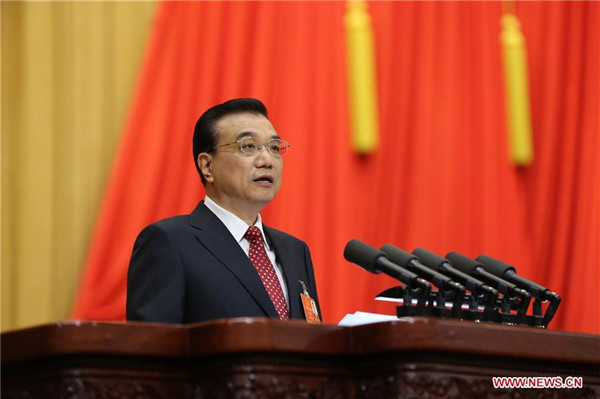 |
|
Chinese Premier Li Keqiang delivers a government work report during the opening meeting of the fourth session of the 12th National People's Congress at the Great Hall of the People in Beijing, capital of China, March 5, 2016. [Xinhua/Liu Weibing] |
Last year's target was "around 7 percent," and China registered 6.9 percent growth, the slowest expansion in a quarter of a century.
This year's target is aligned with China's goal of completing the building of a moderately prosperous society in all respects, and takes into consideration the need to advance structural reform, Li said at the fourth session of the 12th National People's Congress (NPC).
"It will also help guide market expectations and keep them stable. The aim of maintaining stable growth is primarily to ensure employment and promote the people's wellbeing, and a growth rate of between 6.5 percent and 7 percent will allow for relatively full employment," Li said.
The country's urban job creation target remains at least 10 million. Last year's 6.9-percent growth added 13.12 million new urban jobs.
"...China's economic output had exceeded 60 trillion yuan. Every percentage point of GDP growth today is equivalent to 1.5 percentage points of growth five years ago or 2.5 percentage points of growth ten years ago. The larger the economy grows, the greater the difficulty of achieving growth," Li said.
A brief overview of China's 13th Five-Year Plan was also included in Li's report. The country expects an average annual growth rate of at least 6.5 percent from 2016 through 2020, when China will have GDP of 90 trillion yuan ($13.8 trillion).
Target "laudable, achievable"
The adoption of a range in the economic target is China's first since 1995, and offers more flexibility for the government.
In a report ahead of the NPC session, economists with Bank of America Merrill Lynch said a range would be "a laudable move as it would leave some room for structural reforms without stretching on short-term growth objectives."
Hu Angang, an economist with Tsinghua University, echoed the view in comments after the session.
"The range of half a percentage leaves China with more leeway in adapting to complicated scenarios within and outside of the country," Hu said.
In another report ahead of Saturday's session, Mizuho Securities called a target at 6.5 percent or above "ambitious," and anticipated that the growth rate would eventually reach 6.7 percent.
"Based on the official data, and Bloomberg Intelligence Economics' estimate of the potential growth rate, that's testing but achievable," wrote Bloomberg economists in a Saturday note.
The central government's target is more cautious than regional governments, noted Nomura Securities in a calculation.
The weighted-average target for Chinese mainland's 31 provinces, autonomous regions and municipalities, nine of which set their targets as a range instead of a specific number, was 7.5-7.8 percent in 2016, compared to 7.7 percent in 2015, according to Nomura.
Walking a fine line
China is walking a fine line, experts noted, advancing structural reform on the one hand and sustaining proper growth on the other.
By striving for higher growth in 2016, the first year of the 13th Five-Year Plan, the government could get an upper hand for 2020, said Bai Chongen, a Tsinghua University professor and member of the central bank monetary policy committee.
"But the 2016 target should not be set too high," Bai said. "Otherwise it's easy to slide down the slippery slope of stimulus, which could derail reforms."
The work report highlighted strengthening supply-side structural reforms, such as streamlining administration, cutting overcapacity and lowering business costs.
As well as strong stimulus policies, the government will also pursue a more proactive fiscal policy, with increased deficit to cut taxes and promote effective investments, Li said in the work report.
"6.5 percent is the floor rate," said David Daokui Li, a Tsinghua professor and former central bank advisor, "to ensure people's wellbeing."
"Should supply-side reform not make significant progress, stimulus is required to offset the short-term drag on demand," Bloomberg economists wrote in the Saturday note.
